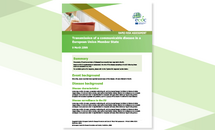Threat assessment brief: Outbreak of novel coronavirus disease 2019 (COVID-19): Situation in Italy
During the course of the day on 22 February, the Italian authorities reported clusters of cases in Lombardy. Initial case identification was based on local laboratory confirmations in the affected Region. Further confirmatory testing is being undertaken by the Italian national reference laboratory and extensive contact tracing is being performed. On 22 February, COVID-19 cases were also reported from two other Regions, Piedmont and Veneto. On 23 February Emilia-Romagna also reported cases. Transmission appears to not be first generation transmission from people travelling or returning from an affected area, but seems to have occurred locally. Transmission events have been reported to have occurred in hospitals, with COVID-19 cases identified among healthcare workers and patients. Two deaths among elderly people have been observed. COVID-19 cases have been identified in multiple
municipalities.
Executive Summary
The information currently available about the different COVID-19 clusters of cases in four Regions in Italy is limited. The situation is dynamically evolving, with more cases expected in the coming days. The risk assessment for the EU/EEA might change when more data become available. The clusters are currently limited to a few Regions in northern Italy. No close contacts or other related cases have been reported to be linked to other European countries.
The risk associated with COVID-19 infection for people from the EU/EEA and UK is currently considered to be low to moderate.
This assessment is based on the following factors:
All previously reported cases in the EU/EEA and UK have clearly established epidemiological links; contact tracing measures have been in place to contain further spread. Extraordinary public health measures have been implemented in northern Italy and strong efforts are being made to identify, isolate and test contacts in order to contain the outbreak. The probability of further transmission in the EU/EEA and the UK is considered to be low, but cannot be excluded because a high level of uncertainties with several unpredictable factors and a situation that is still evolving.
The possibility of new introductions from other countries outside China in the EU/EEA appears to be increasing as the number of non EU/EEA countries reporting cases keeps going up. Among the increasing number of countries reporting COVID-19 cases are Israel, Lebanon, Iran, and Egypt, while the number of cases in countries outside of China (South Korea, Japan) has been increasing over the last few days. This also increases the possibility of cases being introduced from other countries outside China by travellers to the EU/EEA.
The impact of sustained transmission in the EU/EEA would be moderate to high, especially for elderly populations with comorbidities, given that the reported case severity is high among these groups.
The risk of the occurrence of similar clusters, similar to the ones in Italy, associated with COVID-19 in other countries in the EU/EEA and the UK is currently considered to be moderate to high.
This assessment is based on the following factors:
The current event in Italy indicates that local transmission may have resulted in several clusters for which an epidemiological link to areas where ongoing transmission is presumed, was not apparent. The accumulated evidence from clusters reported in the EU/EEA and the UK indicates that once imported, the virus causing COVID19 can transmit rapidly. This may emanate from cases with mild symptoms that do not provoke healthcare-seeking behaviour. The increases in cases and the number of countries outside China reporting those cases increases the potential routes of importation of the infection into the EU/EEA and the UK.
The impact of such clusters in the EU/EEA would be moderate to high, especially if hospitals were affected and a large number of healthcare workers had to be isolated. The impact on vulnerable groups within affected hospitals or healthcare facilities is considered to be severe, in particular for the elderly.
The rigorous public health measures that were implemented immediately after identifying the Italian COVID-19 cases will reduce the impact of such outbreaks as well as the further spread.
The risk for people from the EU/EEA and the UK travelling/resident in areas with presumed community transmission is currently high.
This assessment is based on the following factors:
The overall number of reported cases in areas with community transmission is high or increasing. However, there are significant uncertainties regarding transmissibility and under-detection, particularly among mild or asymptomatic cases.
For travellers/residents, the impact of one or more infections is considered high, especially for elderly populations with comorbidities, because the reported case severity is high in these groups. The impact will also depend on the capacity and availability of healthcare during the epidemic.
The risk for healthcare systems capacity in the EU/EEA and the UK during the peak of the influenza season is low to moderate.
This assessment is based on the following factors:
As the number of reported COVID-19 cases in the EU/EEA and the UK remains low, the probability of widespread infection remains low during the peak of the 2019–2020 influenza season. The majority of countries reported widespread influenza activity for week 7/2020, but the proportion of specimens tested positive in sentinel surveillance is slightly decreasing; some EU/EEA countries might have already moved past the peak period of high influenza circulation: see https://flunewseurope.org.
If a significant increase in COVID-19 cases were to coincide with a high level of influenza activity, the potential impact on healthcare systems would be moderate to high. The increased number of cases would require additional resources for testing, case management, surveillance, and contact tracing. Increased transmission could result in further pressure on healthcare systems. This situation would be exacerbated should a substantial number of healthcare workers become infected.
Download
See also
ECDC statement on the rapid increase of COVID-19 cases in Italy
In the last 24 hours, the Italian Ministry of Health confirmed an increasing number of COVID-19 cases, including two deaths, clustered in two regions in Northern Italy as well as single cases in other regions in Northern Italy.






